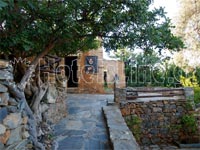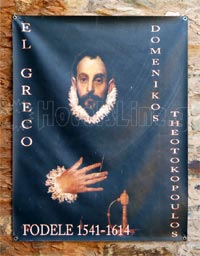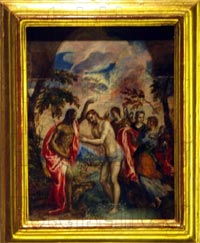 THE MUSEUM OF EL GRECO
Museum
THE MUSEUM OF EL GRECO
Museum

The building that houses the museum was restored under the supervision of the Ministry of Culture and since August of 1998 it began to operate with an exhibition of copies of works by El Greco.
Tradition says that in this house the great painter El Greco 1541 - 1614 was born.
It is said that he was born 25 km northwest of Chandakas (Heraklion), next to a Byzantine church. This area is called Theotokiana and is one of the first settlements of Fodele.
The restoration began in 1982 and lasted five years.
The house was found with serious damage because of the time and it was rebuilt exactly as the original design was. Inside, there are photos of the coming of the professors of the Valiadolid University of Spain on July 27, 1934, where they wanted to pay a tribute to our great painter El Greco and to his native town of Fodele.
Additionally there are photos and information about the unveiling of El Greco's bust, in Fodele in 1964.
Also, you'll see information about the descendants of El Greco, a simulation of the painting room (atelier) and 24 of his paintings in the form of slides.
El Greco, the Cretan, the Greek

El Greco, the Cretan, the Greek, the top painter. He is the General and the grandfather of Kazantzakis. And just the name "Greek" that was given to him, is enough to give us a great honour.
The Master hagiographer that since his young age was already famous in Candakas in the second half of the 16th century, he left his homeland, like so many others, for a universal path. But the first element in his art comes from the Byzantine art, as Chandakas was then the world centre of this art.
A restless spirit, as an authentic Cretan, he opened his wings to Venice of Italy, the metropolis of culture, literature and art in Europe. There he met one of the greatest painters of the time, Titsiano, and incorporated in his painting worldview, as the second basic element, the light (the "Lightning") and the colour.
He ended up to Spain, where his life had an enormous climax. Here, he pitted against the Holy Inquisition. The showdown was between good and evil, moral and immoral, freedom and intolerance, faith and fanaticism. It was the eternal struggle between Light and Darkness.
Greco had all of these in his paintings, the Light and the values of the insubordinate civilization which gave birth to him.
According to tradition, when the painter was in Crete and he painted saints, he signed his works with the name Cris.
 EL GRECO - "THE BAPTISM"
EL GRECO - "THE BAPTISM"

His original work "The Baptism" is at the Historical Museum of Crete, after its purchase by the city of Heraklion with the assistance of many residents with a significant amount, allowing to visitors of the museum to admire one of the finest works of the great painter.
 OPENING HOURS
The museum is daily open, from 9am to 7pm
OPENING HOURS
The museum is daily open, from 9am to 7pm